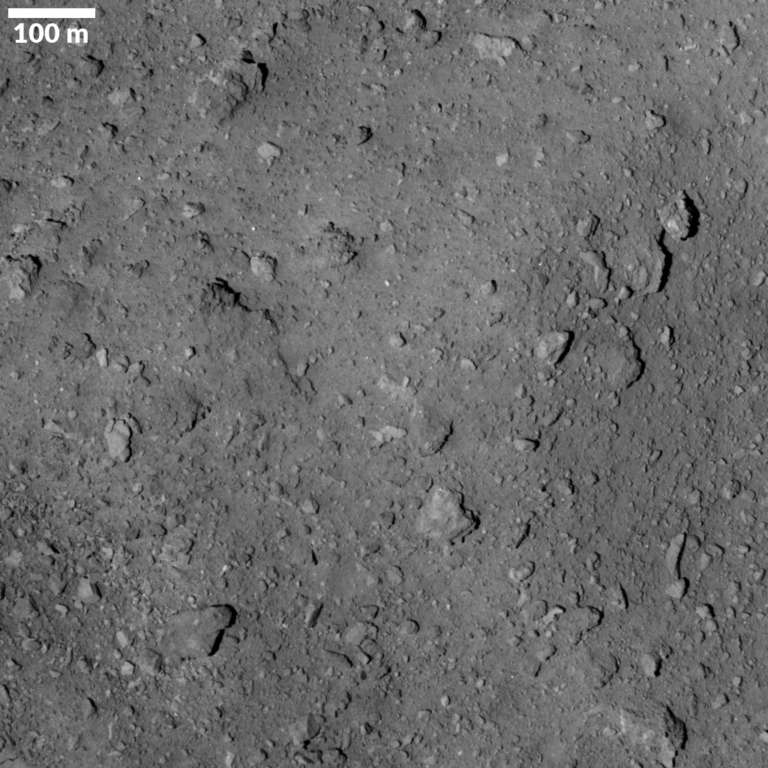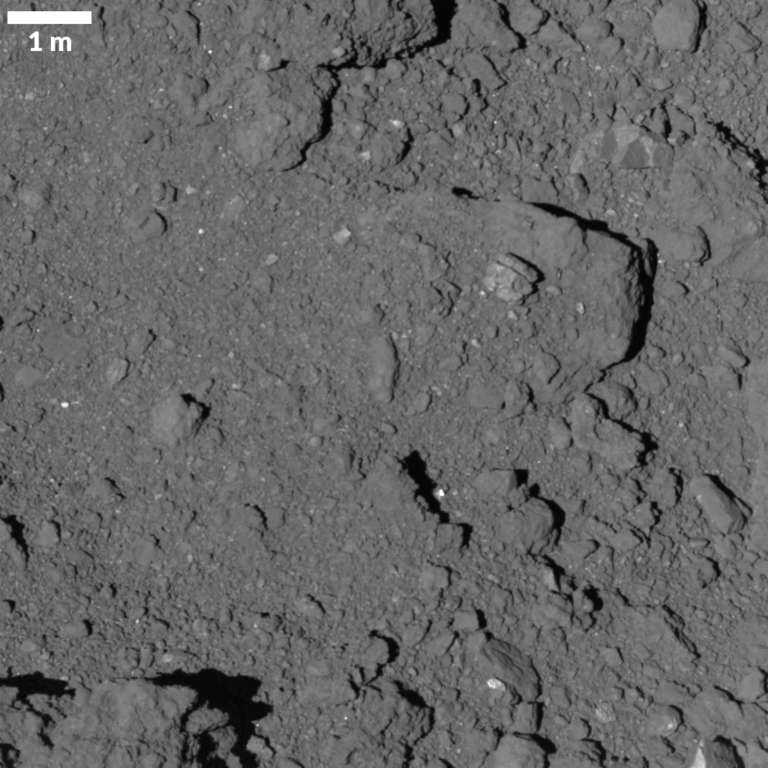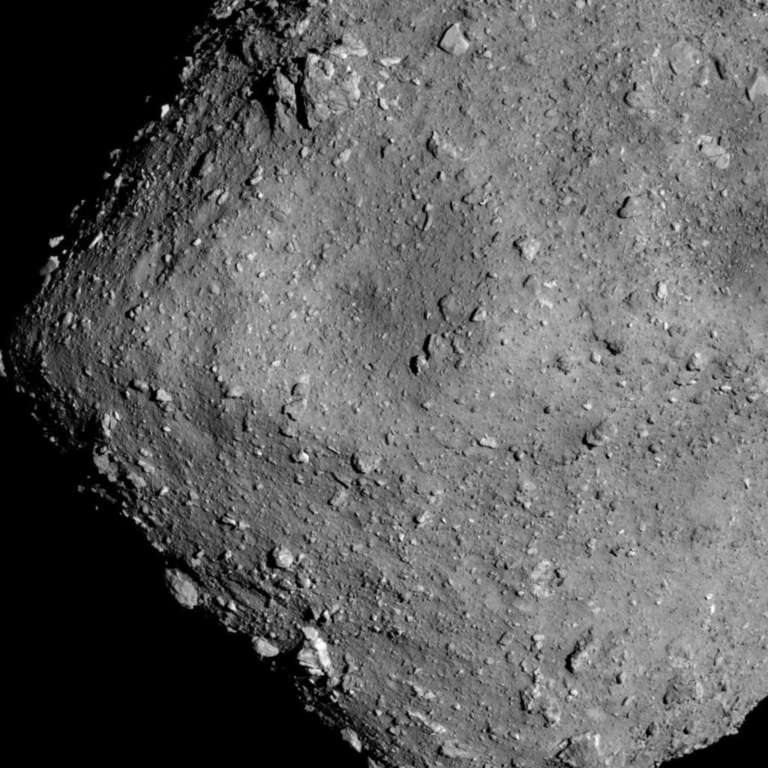Emily Lakdawalla • Apr 01, 2019
First Science Results from Hayabusa2 Mission
What a great week in Houston! With three missions reporting first science results, the celebration of the 50th anniversary of the Apollo 11 landing, and a host of ongoing science from across the solar system, it was intense and fun. For me, the most exciting results were the back-to-back sessions reporting on first looks at Bennu and Ryugu with OSIRIS-REx and Hayabusa2. Jason has already reported out OSIRIS-REx results, so I’ll tell you what the Hayabusa2 team had to say.
Hayabusa2, Japan's mission to Ryugu and other asteroids
Hayabusa2 traveled to the asteroid Ryugu, deployed rovers on its surface, and brought samples back to Earth.

First, the basics: facts about Ryugu.
- It’s a retrograde rotator, with axial tilt 171.64 ± 0.03 degrees, and a spin period of 7.63262 ± 0.00002 hours. They weren’t sure of the pole orientation before seeing the asteroid up close; this particular orientation (nearly perfectly retrograde) was considered the second-most-likely pole position before Hayabusa2 arrived.
- It is top-shaped, with an equatorial bulge. Specifically: Diameter across the equator: 1004 ± 4 meters; across the pole, 875 ± 4 meters.
- Volume: 0.377 ± 0.005 cubic kilometers.
- Density: 1.19 ± 0.02 grams per cubic centimeter.
- Assuming its grains have the density of carbonaceous chondrites (lowest measured density being 2.42 ± 0.06 grams per cubic centimeter), it must have more than 50% porosity.
- It is EXTREMELY dark, with albedo mostly in the range of 1.4 to 1.8 percent, one of the darkest objects ever measured in the solar system.
- The equator appears bluer in color than the higher latitudes. (“Blue” is a relative term. It’s all brownish black, it’s just that the higher latitudes are a ruddier brownish black.)
- Its surface is unexpectedly bouldery—it’s twice as densely populated with boulders as Itokawa was. The largest boulder, near the south pole, named Otohime, is 160 meters across its longest axis.
- No satellites have been found.

The Hayabusa2 team held a press briefing at LPSC on Tuesday to report newly published results. Download their slides here and here, and their movies here. In addition to their press briefing and an afternoon session at LPSC, they published 3 open-access papers led by Sei-Ichiro Watanabe, Kohei Kitazato, and Seiji Sugita and coauthors. Many thanks to Sugita-san for placing online the raw data for all the images his group presented in their paper, which I’ve pulled from for the pictures in this article!
Any near-Earth asteroid as small as Ryugu (or Bennu) cannot be very old, geologically speaking. There are forces that act to change an asteroid’s orbit over time (the Yarkovsky effect) and that act to spin it up over time (YORP). The smaller the asteroid, the more rapidly these forces operate. Yarkovsky and YORP conspire to make asteroids impact inner planets or spin up so fast they disrupt within a couple hundred million years.
So the basic story for these worlds is that they originated in the main belt, as fragments of a previously larger body, blasted off in some ancient collision, and some series of gravitational encounters delivered them to near-Earth orbital space within the last couple hundred million years. So what bigger main-belt asteroid did they come from? That is, which main-belt asteroid will we have pieces of when we return the Hayabusa2 and OSIRIS-REx samples to Earth? Sugita-san presented some spectroscopic evidence of which asteroids might be the parent bodies. The best matches are 142 Polana and 495 Eulalia, but even these aren’t perfect.
What about meteorites? That’s also mysterious. Ryugu was predicted to have a typical carbonaceous asteroid albedo of around 3 or 4 percent, but not only is it darker than known asteroids, it’s also darker than any carbonaceous chondrite meteorite measured in the laboratory. The composition of Ryugu’s surface materials appears pretty homogeneous, with every spectrum containing evidence for the ubiquitous presence of a very small amount of hydroxyl ion, OH-, in Ryugu’s minerals, probably in a magnesium-rich clay mineral. That means the materials composing Ryugu once interacted with water—a pretty common finding in meteorites.
The best laboratory match that’s been found for what they’re seeing at Ryugu is meteorites that have been cooked – “thermally metamorphosed” meteorites. Long ago, the rocks that made Ryugu formed in the warm interior of a young, biggish asteroid. This asteroid was large enough for internally-driven geology so would’ve been several hundred kilometers across. In the warm asteroid there was liquid water percolating among the rocks, which altered the minerals, stuffing hydroxyl ions inside them. But then they got heated even more—maybe it was really early in solar system formation when there was aluminum-26 around to generate lots of heat by radioactive decay, or maybe it happened in a violent impact—and the extra heating decomposed some of the hydrated minerals to other forms and darkened the rock. There is certainly evidence of at least some of Ryugu’s rocks having experienced a large impact and resolidifying in new rock. Check out the breccia block in this photo.

Zooming in:

What can we learn from Ryugu’s shape? It is surprisingly symmetrical and even; the asteroid is diamond-shaped in profile, but nearly perfectly circular when viewed from the top. The ground slopes away from the equator quite steeply, at about 34 degrees. Rubble-pile asteroids can achieve these shapes if they spin fast enough, but Ryugu would have to be spinning much faster than it is now—once in a little under 4 hours—to naturally form the shape it has today. The presence of craters on the surface of the equatorial ridge suggests that the ridge is a fairly old feature. But the relative blueness of the ridge suggests that it’s younger than the midlatitudes. Mysterious.

I read Seiji Sugita et al.’s paper on the geomorphology of Ryugu to get a little bit more detail. They describe at least 30 circular depressions that are more than 20 meters across. Craters, right? Maybe. More than half have raised rims, which geologists consider fairly diagnostic of impact craters, at least on worlds this small. (Circular depressions that don’t have raised rims could be other things, like pits where material drained from the surface into a void underground, or places where centrifugal force caused large boulders to launch off the surface.) Some of the circular depressions have bowl shapes, which is expected for craters, while others have shallow floors, which would have to mean that a crater got filled with material somehow after it formed. In general, the shapes of the things that look like impact craters tell us that Ryugu doesn’t have any internal strength or cohesion; it really is a pile of rubble.
Ryugu’s boulderiness was very unexpected. Ryugu is a small world and it’s just covered with boulders that are up to a few meters across. Those big boulders may be why there aren’t many small craters on Ryugu. The craters that we see on Ryugu are 1 to 30 meters in diameter. The particles that would’ve made those craters would be 0.1 to 1 meter across—just a bit smaller than the boulders that cover Ryugu. No smaller craters formed on Ryugu because its boulder surface acts as an armor that prevents smaller projectiles from making craters. A small impactor, hitting one of those boulders, would just fracture or disrupt the boulder, not dig a crater.

Still, even with the argument about armoring, there are fewer small craters on Ryugu than you’d expect. At least, by comparison to the Moon or Mercury. However, if you compare it to Itokawa and Eros, those littler near-Earth asteroids also have a dearth of small craters. People usually argue that seismic shaking erases small craters. That is, when a biggish impact happens, it gives the whole asteroid a good hard shake, and the boulders settle, and the littler craters get harder to see. After a few bigger impacts, the littler craters are gone. Counting the littlest craters, 10 meters across, it looks like craters in that size range get erased within a million years or so. So all the craters we can see in that size range formed roughly that recently—some of them much more recently than that.None of those craters will be quite as fresh as the one that Hayabusa2 is about to create, though. Jason Davis tells you that story.
It’s still very early in the Hayabusa2 mission. Mostly, what I’ve laid out here is description of a newly observed asteroid. There are not a lot of answers to the questions of where it came from, what its geologic history looked like, and how its surface came to appear as it does. In fact, this early phase of a mission to a never-before-explored world is more about coming up with new questions than it is about answering old ones. We’ll get answers to some of these questions as Hayabusa2 completes its mapping and scientists analyze the data. We’ll get answers to more questions later, after the samples are returned and divvied up to labs worldwide and analyzed with every laboratory technique known to humanity. And some of these questions won’t be answered satisfactorily. It’s all part of the fun of planetary exploration.
Support our core enterprises
Your support powers our mission to explore worlds, find life, and defend Earth. You make all the difference when you make a gift. Give today!
Donate

 Explore Worlds
Explore Worlds Find Life
Find Life Defend Earth
Defend Earth


